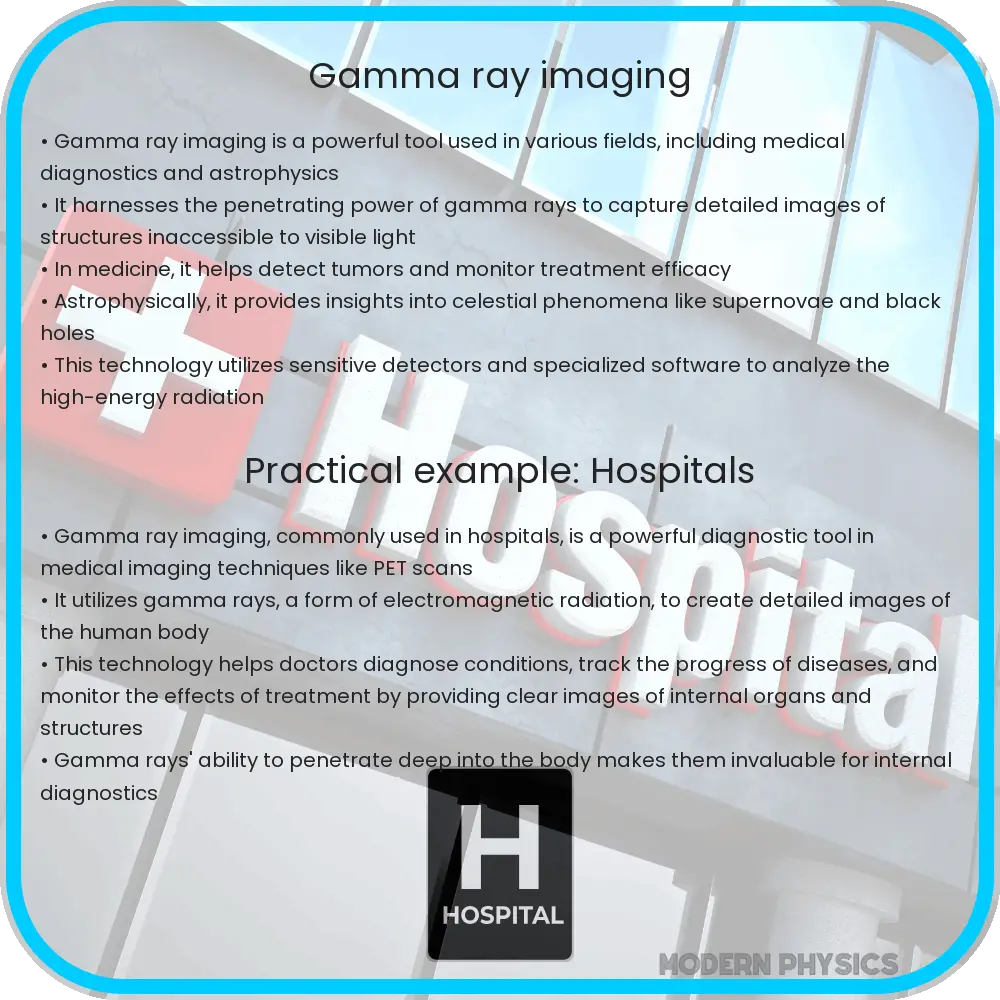Gamma ray imaging is used in medical diagnostics, industrial inspections, and astronomical observations to detect gamma rays and analyze internal structures.

Introduction to Gamma Ray Imaging
Gamma ray imaging is a sophisticated technology utilized primarily in the fields of medical diagnostics, industrial inspection, and astronomical observations. This technique revolves around the detection of gamma rays – high-energy electromagnetic radiation emitted from atomic nuclei. Gamma rays possess the ability to penetrate most materials, making them a powerful tool for probing structures that are otherwise inaccessible with other forms of radiation such as visible light or X-rays.
Uses of Gamma Ray Imaging
- Medical Diagnostics: In the medical sector, gamma ray imaging is most famous for its role in nuclear medicine. Technologies such as positron emission tomography (PET) and single photon emission computed tomography (SPECT) are critical in diagnosing diseases, including various types of cancer, by observing metabolic processes in the body.
- Industrial Inspection: In industry, gamma rays are used for non-destructive testing (NDT) of materials and structures. This application is essential in evaluating the integrity of pipelines, turbines, and welds, particularly in the aerospace, oil, and gas industries.
- Astronomical Observations: In astronomy, gamma ray telescopes facilitate the study of celestial phenomena such as pulsars, quasars, and gamma-ray bursts (GRBs), providing insights into the most energetic processes in the universe.
Techniques in Gamma Ray Imaging
Gamma ray imaging techniques vary depending on their application, but the fundamental principle involves the detection and analysis of gamma radiation that interacts with matter. Here are some core technologies:
- Scintillation Detectors: These detectors use scintillator materials that fluoresce when hit by gamma rays, producing light that is then converted to an electrical signal.
- Semiconductor Detectors: Semiconductor devices, like germanium or silicon detectors, operate by collecting charge carriers that are mobilized when gamma rays interact with the semiconductor material.
- Compton Cameras: Used primarily in medical imaging, Compton cameras exploit the Compton scattering effect, where gamma rays scatter off electrons in a detector. This scattering helps reconstruct the paths of the gamma rays, providing a 3D image of their origins.
Benefits of Gamma Ray Imaging
Gamma ray imaging offers several distinct advantages:
- Non-invasive and Safe: Gamma rays, when used properly, provide a non-invasive method to inspect the internal workings of complex systems in medicine and industry without requiring disassembly or direct contact.
- High Penetration: Due to their high energy, gamma rays can penetrate materials that are opaque to other forms of electromagnetic radiation, enabling the inspection of heavily shielded or dense objects.
- Precise Diagnostics: In medicine, gamma ray imaging allows for precise localization and characterization of diseases, leading to improved diagnosis and targeted therapies.
Challenges and Limitations of Gamma Ray Imaging
Despite its numerous benefits, gamma ray imaging faces certain challenges that limit its widespread application:
- Radiation Exposure: Gamma rays are a form of ionizing radiation that can be harmful if not properly managed. Ensuring the safety of patients and workers is paramount, requiring stringent safety protocols and exposure limits.
- High Cost: The equipment used in gamma ray imaging, particularly in medical applications like PET and SPECT, is highly sophisticated and expensive to manufacture and maintain.
- Technical Complexity: Operating gamma ray imaging systems requires highly skilled technicians and specialists, which can pose a challenge particularly in regions lacking trained professionals.
Future Directions in Gamma Ray Imaging
Research and development in gamma ray imaging continue to evolve, driven by advances in technology and an increased understanding of its potential applications:
- Advancements in Detector Technology: Ongoing research is focused on developing more efficient and less expensive detector materials, which would make gamma ray imaging systems more accessible and cost-effective.
- Improved Safety Measures: Innovations in safety and shielding techniques are continually being developed to reduce the risks associated with radiation exposure during gamma ray imaging procedures.
- Expansion of Applications: Scientists are exploring new uses for gamma ray imaging in fields such as environmental monitoring and security, broadening its applicability beyond the traditional domains of medicine and astronomy.
Conclusion
Gamma ray imaging stands as a critical technology in modern science and industry. Its ability to provide detailed insights into complex systems across various fields—from medical diagnostics to astronomical research—highlights its significant role. However, like any technology, it comes with its set of challenges that need continuous attention from the scientific community. The road ahead for gamma ray imaging is promising, with potential enhancements in safety, affordability, and application scopes potentially revolutionizing how we utilise this powerful tool. As technology progresses, we may see gamma ray imaging becoming even more integral to tackling some of the most pressing challenges in healthcare, industry, and research.
